Growth Response of Pinus tabuliformis and Abies fargesii to Climate Factors in Southern Slope of Central Qinling Mountains of China
Abstract
1. Introduction
2. Materials and Methods
2.1. Tree-Ring Data
2.2. Meteorological Data and Statistical Methods
3. Results
4. Discussion
4.1. Climate and Tree-Ring Growth Relationship
4.2. Extreme Events and Regional Hydroclimate
4.3. Periodicity and Large-Scale Climate Forcing
5. Conclusions
Author Contributions
Funding
Data Availability Statement
Acknowledgments
Conflicts of Interest
References
- Physical Geography in China Editorial Board of Chinese Academy of Sciences. Physical Geography in China: Introduction; Science Press: Beijing, China, 1985. [Google Scholar]
- Kang, M.Y.; Zhu, Y. Discussion and analysis on the geo-ecological boundary in Qinling Range. Acta Ecol. Sin. 2007, 27, 2774–2784. [Google Scholar]
- Miao, Q.L.; Ding, Y.Y.; Wang, Y. Impact of climate warming on the northern boundary of subtropical zone of China. Geogr. Res. 2009, 28, 634–642. [Google Scholar]
- Zhou, Q.; Dian, J.J.; Zhen, J.Y. Variation of Air Temperature and Thermal Resources in the Northern and Southern Regions of the Qinling Mountains from 1951 to 2009. Acta Geogr. Sin. 2011, 66, 1211–1218. [Google Scholar]
- Ding, M.; Huang, C.C. The influence of climatic warming on fruit produce in northern foot of Qinling Mountain. J. Nat. Resour. 2003, 18, 235–239. [Google Scholar]
- Ji, L.; Duan, K.Q. What is themain driving force of hydrological cycle variations in the semiarid and semi-humid Weihe River Basin, China? Sci. Total Environ. 2019, 684, 254–264. [Google Scholar] [CrossRef]
- Bradley, R.S. High-Resolution Paleoclimatology; Hughes, M.K., Swetnam, T.W., Diaz, H.F., Eds.; Springer: Dordrecht/Heidelberg, Germany; London, UK; New York, NY, USA, 2010. [Google Scholar]
- Shao, X.M.; Wu, X.D. Tree-ring chronologies for Pinus Armandi Franch from Huanshan, China. Acta Geogr. Sin. 1994, 49, 174–181. [Google Scholar]
- Hughes, M.K.; Wu, X.D.; Shao, X.M.; Garfin, G.M. A preliminary reconstruction of rainfall in North-Central China since AD1600 from tree-ring density and width. Quat. Res. 1994, 42, 88–99. [Google Scholar] [CrossRef]
- Chen, F.; Zhang, R.; Wang, H.; Qin, L.; Yuan, Y. Updated precipitation reconstruction (AD 1482–2012) for Huashan, north-Central China. Theor. Appl. Climatol. 2016, 123, 723–732. [Google Scholar] [CrossRef]
- Liu, Y.; Linderholm, H.W.; Song, H.; Cai, Q.; Tian, Q.; Sun, J.; Chen, D.; Simelton, E.; Seftigen, K.; Tian, H.; et al. Temperature variations recorded in Pinus tabulaeformis tree rings from the southern and northern slopes of the central Qinling Mountains, central China. Boreas 2009, 38, 285–291. [Google Scholar] [CrossRef]
- Dang, H.; Jiang, M.; Zhang, Q.; Zhang, Y. Growth responses of subalpine fir (Abies fargesii) to climate variability in the Qinling Mountain, China. For. Ecol. Manag. 2007, 240, 143–150. [Google Scholar] [CrossRef]
- Hu, Z.S.; Zheng, Y.H.; Lu, C.Y.; Su, Q.H. Effect of Window Width on Relationship between Tree Radial Growth and Climatic Elements. J. Northeast For. Univ. 2023, 51, 40–42, 49. [Google Scholar]
- Qin, J.; Bai, H.Y.; Zhao, P.; Yang, N.J.; Yue, J.W. Age-dependent response of Abies fargesii tree radial growth to climatic factors in the Qinling Mountains. Acta Ecol. Sin. 2022, 42, 7167–7176. [Google Scholar]
- Liu, Y.; Liu, N.; Song, H.M.; Cai, Q.F.; Bao, G.; Wang, W.P. Reconstructed mean air temperature from January to July at the divide sampling site in the Mid-Qinling Mountains with tree-ring widths. Adv. Clim. Change Res. 2009, 5, 260–265. [Google Scholar]
- Liu, N.; Liu, Y.; Zhou, Q.; Bao, G. Droughts and broad-scale climate variability reflected by temperature-sensitive tree growth in the Qinling Mountains, central China. Int. J. Biometeorol. 2013, 57, 169–177. [Google Scholar] [CrossRef]
- Hu, Y.F.; Bao, G.; Liu, N.; Qu, Y. May–July mean minimum temperature variability in the mid-Qinling Mountains, central China, since 1814 CE. Quat. Int. 2018, 476, 102–109. [Google Scholar] [CrossRef]
- Bao, G.; Liu, N.; Wu, M.; Liu, Z. Streamflow variability in the past four centuries for the largest tributary of the Yellow River and its teleconnection with large-scale climate forcing. Int. J. Climatol. 2022, 42, 4460–4476. [Google Scholar] [CrossRef]
- Sun, C.F.; Liu, Y. Tree-ring-based drought variability in the eastern region of the Silk Road and its linkages to the Pacific Ocean. Ecol. Indic. 2019, 96, 421–429. [Google Scholar] [CrossRef]
- Li, J.Y.; Fu, B.J.; Sun, J.L.; Hong, Z.L.; Zhang, B.P.; Wang, X.F.; Bai, H.Y.; Wang, F.; Zhao, Z.B.; Cao, X.S. Ecological civilization construction at Qinling Mountains in the New Era. J. Nat. Resour. 2021, 36, 2449–2463. [Google Scholar] [CrossRef]
- Zhang, B.P. Ten major scientific concerning the study of China’s north-south transitional zone. Prog. Geogr. 2019, 38, 305–311. [Google Scholar]
- Ma, X.P.; Bai, H.Y.; Guo, S.; Deng, C.H.; Han, S.S. Verification of temperature vertical lapse rate and mountain climate characteristics of Taibai Mountains in Qinling Mountains. J. Arid Land Resour. Environ. 2017, 31, 139–144. [Google Scholar]
- Yang, Y.R.; Zhang, M.S.; Zhang, L.N.; Lu, Q.Q.; Hong, Y.X.; Liu, X.H. Different responses of radial growth of Pinus tabuliformis to climate in the middle and western Qinling Mountains. Acta Ecologica Sinica 2022, 42, 1474–1486. [Google Scholar]
- Yang, Z.R.; Zhang, J.P. Species Diversity of Abies fargesii Natural Forest Community in Mt. Taibai of Qinling. J. Northwest For. Univ. 2023, 38, 140–146. [Google Scholar]
- Li, G.C.; Song, H.D.; Li, Q.; Bu, S.H. Spatial point pattern analysis of main trees and flowering Fargesia qinlingensis in Abies fargesii forests in Mt. Taibai of the Qinling Mountains, China. Chin. J. Appl. Ecol. 2017, 28, 3487–3493. [Google Scholar]
- Chen, Y.P. Significance and strategies on the ecological civilization construction at Qinling Mountains. J. Earth Environ. 2019, 10, 1–11. [Google Scholar]
- Li, K.F.; Gong, B.; Wu, Y. Ecological protection and ecological civilization construction in Qinling Mountains. China Ecol. Civiliz. 2021, 3, 40–42. [Google Scholar]
- Fritts, H.C. Tree-Rings and Climate; Academic Press: London, UK, 1976. [Google Scholar]
- Holmes, R.L. Computer-assisted quality control in tree-ring dating and measurement. Tree Ring Bull. 1983, 43, 69–95. [Google Scholar]
- Cook, E.R.; Kairiukstis, L.A. Methods of Dendrochronology: Applications in the Environmental Sciences; Kluwer Academic Publishers: Boston, MA, USA, 1990. [Google Scholar]
- Wu, X.D.; Shao, X.M. A study on the reliability of tree-ring data-an example of Huashan Pine from Shaanxi. Prog. Geogr. 1997, 16, 51–56. [Google Scholar]
- Linderholm, H.W.; Seima, A.; Ou, T.H.; Jeong, J.H.; Liu, Y.; Wang, X.C.; Bao, G.; Folland, C. Exploring teleconnections between the summer NAO (SNAO) and climate in East Asia over the last four centuries—A tree-ring perspective. Dendrochronologia 2013, 13, 297–310. [Google Scholar] [CrossRef]
- Dai, J.H.; Shao, X.M.; Cui, H.T.; Ge, Q.S.; Liu, H.Y.; Tang, Z.Y. Reconstruction of past eco-climate by tree-ring width index of Larix Chinensis on Mt. Taibai. Quat. Sci. 2003, 23, 428–435. [Google Scholar]
- Chinese Academy of Meteorological Sciences. Yearly Charts of Dryness/Wetness in China for the Last 500-Year Period; SinoMaps Press: Beijing, China, 1981. [Google Scholar]
- Mitchell, T.D.; Jones, P.D. An improved method of constructing a database of monthly climate observations and associated high resolution grids. Int. J. Climatol. 2005, 25, 693–712. [Google Scholar] [CrossRef]
- Vicente-Serrano, S.M.; Beguería, S.; Lopez-Moreno, J.I. A multiscalar drought index sensitive to global warming: The standardized precipitation evapotranspiration index-SPEI. J. Clim. 2010, 23, 1696–1718. [Google Scholar] [CrossRef]
- Mann, M.E.; Lees, J. Robust estimation of background noise and signal detection in climatic time series. Clim. Change 1996, 33, 409–445. [Google Scholar] [CrossRef]
- Fang, K.Y.; Gou, X.H.; Chen, F.H.; Liu, C.Z.; Davi, N.; Li, J.B.; Zhao, Z.Q.; Li, Y.J. Tree-ring based reconstruction of drought variability (1615–2009) in the Kongtong Mountain area, northern China. Glob. Planet. Change 2012, 80–81, 190–197. [Google Scholar] [CrossRef]
- Fang, K.Y.; Gou, X.H.; Chen, F.H.; D’Arrigo, R.; Li, J.B. Tree-ring based droughtreconstruction for the Guiqing Mountain (China): Linkages to the Indian and Pacific Oceans. Int. J. Climatol. 2010, 30, 1137–1145. [Google Scholar] [CrossRef]
- Fang, K.Y.; Gou, X.H.; Chen, F.H.; David, F.; Liu, C.Z.; Li, J.B.; Miklos, K. Precipitation variability during the past 400 years in the Xiaolong Mountain(central China) inferred from tree rings. Clim. Dyn. 2012, 39, 1697–1707. [Google Scholar] [CrossRef]
- Liu, N.; Bao, G.; Liu, Y.; Linderholm, H.W. Two centuries-long streamflow reconstruction inferred from tree rings for the middle reaches of the Weihe River in Central China. Forests 2019, 10, 208. [Google Scholar] [CrossRef]
- Li, Y.J.; Wang, S.Y.; Niu, J.J.; Fang, K.Y.; Chao, Y.; Li, X.L.; Li, Y.H. Tree-ring-based reconstruction of drought variability (1792–2011) in the middle reaches of the Fen River, North China. Dendrochronologia 2016, 40, 1–11. [Google Scholar] [CrossRef]
- Liang, F.F.; Zhu, Q.K.; Wang, L.L.; Li, P.; Zheng, X.L.; Zhao, Y.M. Influence of climate factors on radial growth of Pinus tabulaeformis in loess area of Northern Shaanxi. J. Northwest AF Univ. (Nat. Sci. Ed.) 2015, 43, 33–41. [Google Scholar]
- Tang, M.L.; Xiao, C.; Yuan, W.H. Comparative analysis of hourly features of precipitation in the north and south areas of Qinling Mountains. Torrential Rain Disasters 2022, 41, 24–32. [Google Scholar]
- Zhang, C.; Wang, Z.Y.; Zhou, B.T.; Li, Y.H.; Tang, H.Y.; Xiang, B. Trends in autumn rain of West China from 1961 to 2014. Theor. Appl. Climatol. 2019, 135, 533–544. [Google Scholar] [CrossRef]
- Wei, T.; He, S.P.; Yan, Q.; Dong, W.J.; Wen, X.H. Decadal shift in West China autumn precipitation and its association with sea surface temperature. J. Geophys. Res. Atmos. 2018, 123, 835–847. [Google Scholar] [CrossRef]
- Liu, X.D.; Fang, J.G.; Yang, X.C.; Li, X.Z. Climatology of dekadly precipitation around the Qinling mountains and characteristics of its atmospheric circulation. Arid Meteorol. 2023, 21, 8–13. [Google Scholar]
- Gao, J.; Yang, B.; He, M.; Shishov, V. Intra-annual stem radial increment patterns of Chinese pine, Helan Mountains, northern central China. Trees 2019, 33, 751–763. [Google Scholar] [CrossRef]
- Yi, L.; Yu, H.J.; Ge, J.Y.; Lai, Z.P.; Xu, X.Y.; Qin, L.; Peng, S.Z. Reconstructions of annual summer precipitation and temperature in north-Central China since 1470 AD based on drought/flood index and tree-ring records. Clim. Change 2012, 110, 469–498. [Google Scholar] [CrossRef]
- Liang, E.; Liu, X.; Yuan, Y.; Qin, N.; Fang, X.; Huang, L.; Zhu, H.; Wang, L.; Shao, X. The 1920s drought reconstructed by tree rings and historical documents in the semi-arid and arid areas of northern China. Clim. Change 2006, 79, 403–432. [Google Scholar] [CrossRef]
- Liu, Z.; Menzel, L.; Dong, C.; Fang, R. Temporal dynamics and spatial patterns of drought and the relation to ENSO: A case study in Northwest China. Int. J. Climatol. 2016, 36, 2886–2898. [Google Scholar] [CrossRef]
- Zhang, R.H.; Min, Q.Y.; Su, J.Z. Impact of El Niño on atmospheric circulations over East Asia and rainfall in China: Role of the anomalous western North Pacific anticyclone. Sci. China Earth Sci. 2017, 60, 1124–1132. [Google Scholar] [CrossRef]
- Qian, C.; Zhou, T. Multidecadal variability of North China aridity and its relationship to PDO during 1900–2010. J. Clim. 2014, 27, 1210–1222. [Google Scholar] [CrossRef]
- Peng, Y. Simulated interannual teleconnection between the summer North Atlantic oscillation and summer precipitation in eastern China during the last millennium. Geophys. Res. Lett. 2018, 45, 7741–7747. [Google Scholar] [CrossRef]
- Li, J.P.; Ruan, C.Q. The North Atlantic–Eurasian teleconnection in summer and its effects on Eurasian climates. Environ. Res. Lett. 2018, 13, 024007. [Google Scholar] [CrossRef]
- Li, J.P.; Wang, J.X. A new North Atlantic oscillation index and its variability. Adv. Atmos. Sci. 2003, 20, 661–676. [Google Scholar]

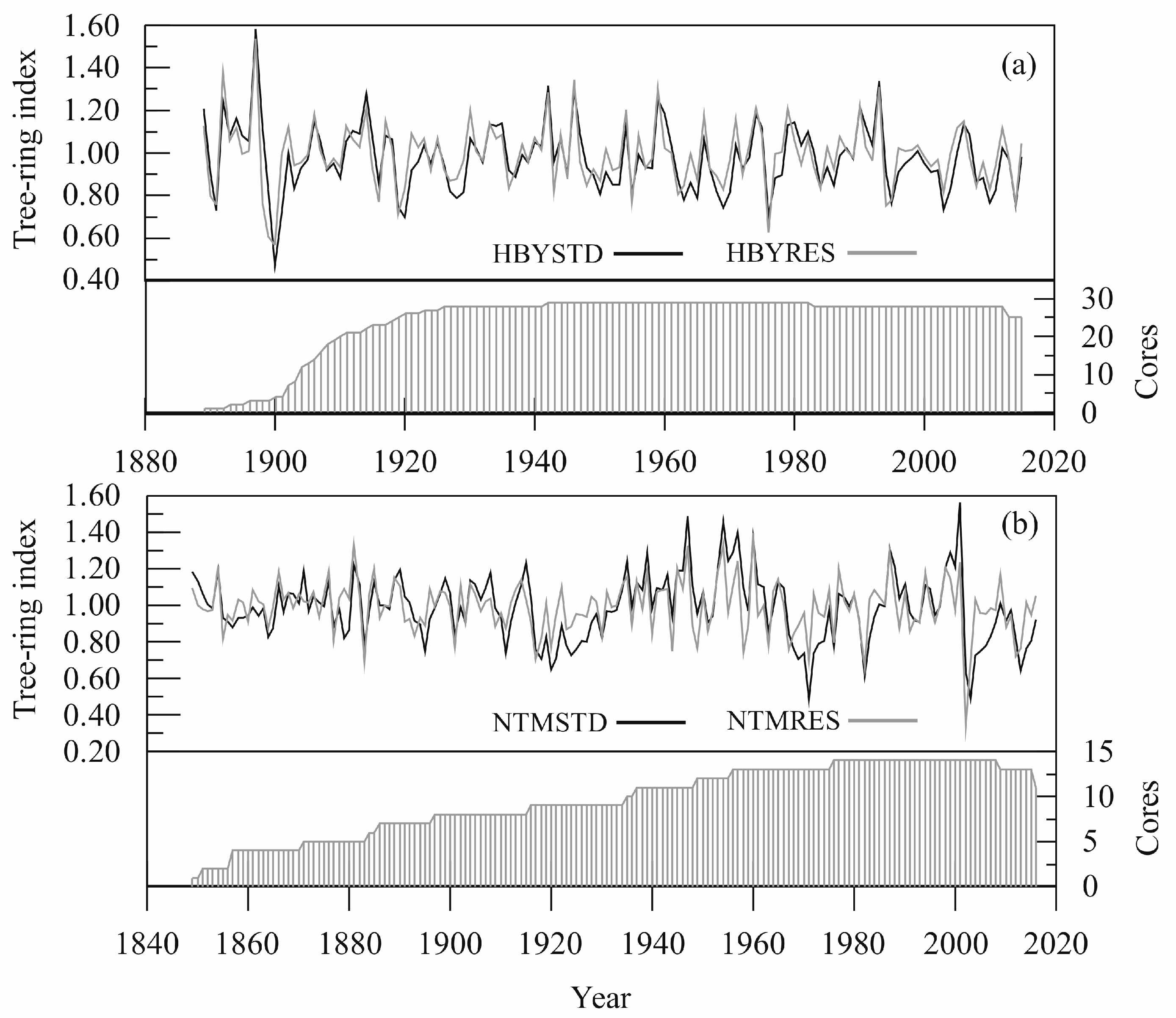
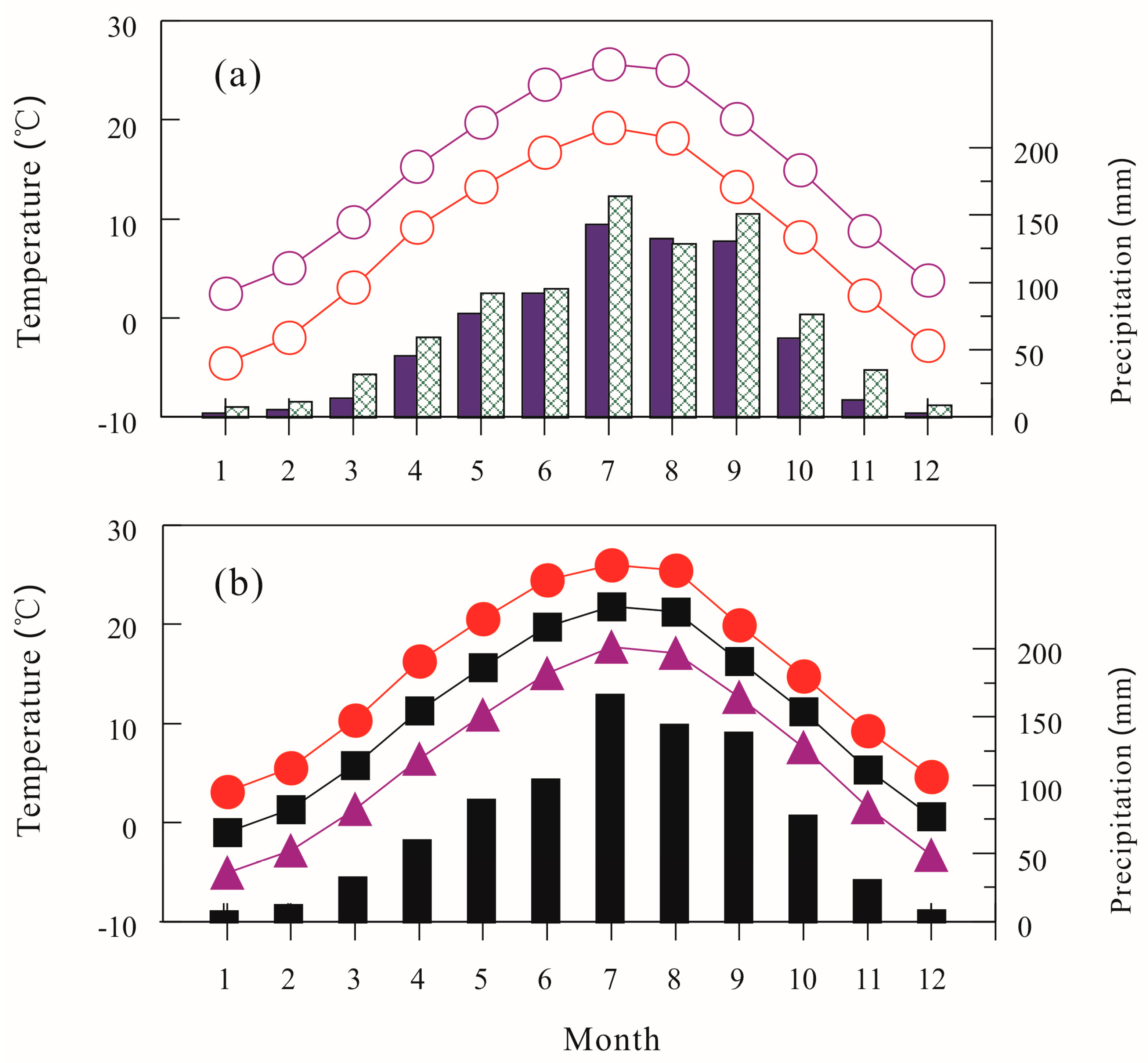
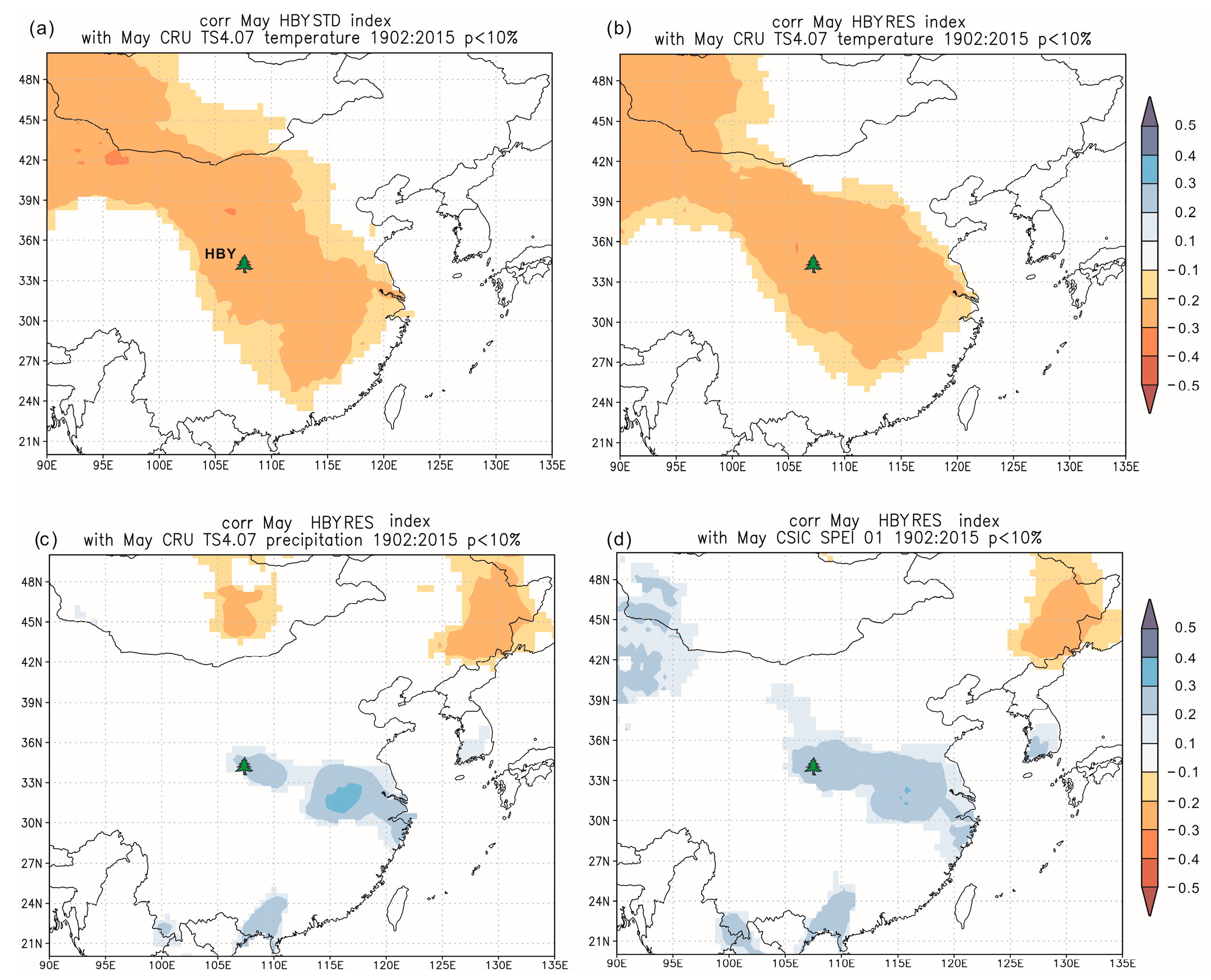
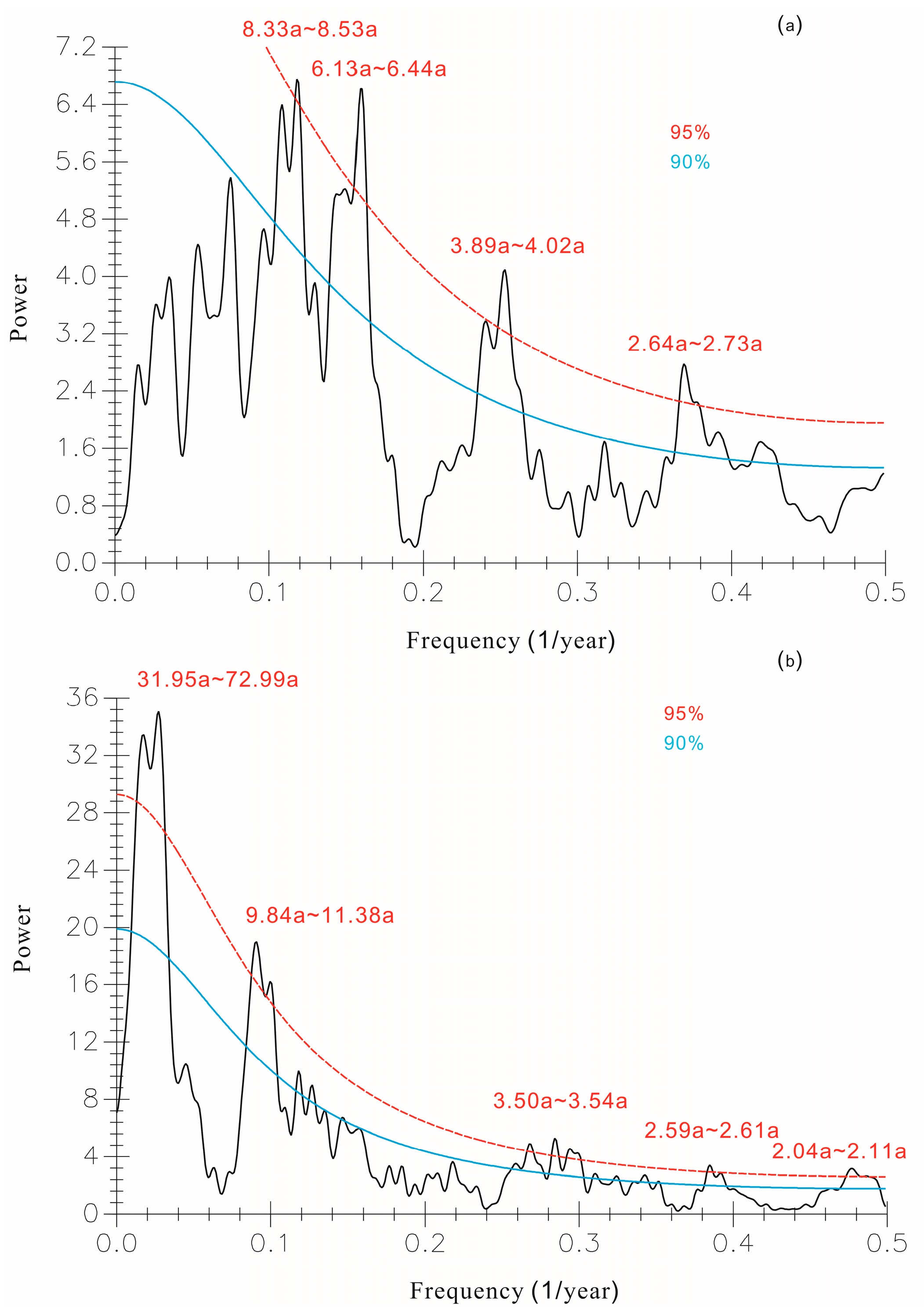
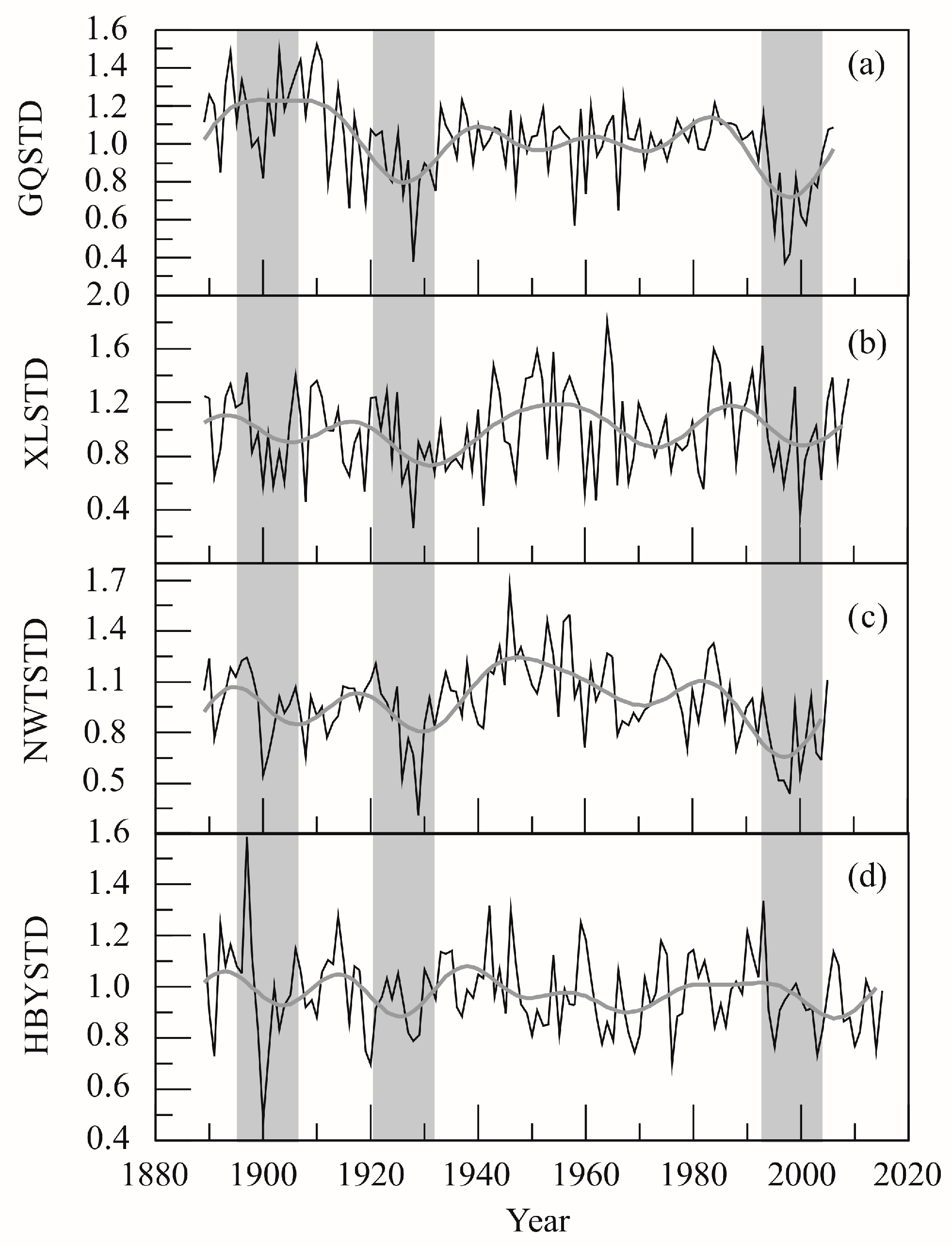
| Statistics | Tree-Ring Width Chronology | |||
|---|---|---|---|---|
| HBYSTD | HBYRES | NTMSTD | NTMRES | |
| Mean value | 0.976 | 0.991 | 0.985 | 0.993 |
| Standard deviation (SD) | 0.157 | 0.154 | 0.179 | 0.145 |
| Mean sensitivity (MS) | 0.147 | 0.180 | 0.133 | 0.170 |
| Serial correlation | 0.323 | −0.142 | 0.548 | −0.061 |
| Signal-to-noise ratio (SNR) | 2.899 | 8.621 | 5.707 | 8.127 |
| Expressed population signal (EPS) | 0.744 | 0.896 | 0.851 | 0.890 |
| Variance of the first eigenvector (%) | 22.500 | 30.700 | 47.400 | 51.800 |
| Length of chronology | 127 | 127 | 168 | 168 |
| Month | HBYSTD vs. Thz | HBYSTD vs. Phz | HBYSTD vs. Ttb | HBYSTD vs. Ptb | HBYRES vs. Thz | HBYRES vs. Phz | HBYRES vs. Ttb | HBYRES vs. Ptb |
|---|---|---|---|---|---|---|---|---|
| P5 | −0.177 | 0.065 | −0.221 | 0.094 | 0.005 | 0.063 | 0.006 | 0.085 |
| P6 | −0.086 | −0.033 | −0.247 | 0.069 | −0.058 | −0.155 | −0.164 | −0.079 |
| P7 | −0.030 | 0.009 | −0.068 | −0.001 | −0.007 | −0.012 | −0.070 | −0.151 |
| P8 | −0.215 | 0.168 | −0.271 | 0.187 | −0.201 | 0.143 | −0.198 | 0.180 |
| P9 | −0.107 | −0.100 | −0.136 | −0.089 | −0.060 | 0.006 | −0.015 | −0.096 |
| P10 | −0.151 | −0.170 | −0.218 | −0.164 | −0.182 | −0.155 | −0.142 | −0.211 |
| P11 | 0.086 | −0.111 | 0.033 | −0.058 | −0.012 | −0.133 | −0.039 | −0.075 |
| P12 | 0.031 | −0.005 | 0.119 | −0.149 | 0.093 | 0.071 | 0.194 | −0.126 |
| C1 | 0.101 | 0.293 * | 0.063 | −0.057 | 0.198 | 0.256 | 0.063 | −0.095 |
| C2 | 0.077 | 0.126 | 0.099 | 0.038 | 0.046 | 0.064 | 0.106 | 0.100 |
| C3 | −0.043 | 0.118 | −0.038 | 0.123 | −0.012 | 0.061 | 0.015 | 0.056 |
| C4 | 0.147 | −0.204 | −0.009 | −0.144 | 0.253 | −0.103 | 0.170 | −0.052 |
| C5 | −0.348 ** | 0.043 | −0.404 ** | 0.034 | −0.369 ** | 0.075 | −0.402 ** | 0.116 |
| C6 | −0.032 | 0.103 | −0.136 | 0.199 | −0.006 | 0.026 | −0.108 | 0.194 |
| C7 | −0.040 | −0.027 | −0.012 | 0.236 | 0.061 | −0.066 | 0.146 | 0.101 |
| C8 | −0.065 | 0.012 | −0.132 | 0.001 | −0.024 | −0.108 | −0.030 | −0.178 |
| C9 | −0.047 | −0.206 | −0.224 | −0.046 | 0.002 | −0.126 | −0.162 | 0.046 |
| C10 | −0.005 | −0.050 | −0.207 | 0.089 | 0.138 | −0.061 | −0.043 | 0.066 |
| Month | NTMSTD | NTMRES | ||||||
|---|---|---|---|---|---|---|---|---|
| T | Tmax | Tmin | P | T | Tmax | Tmin | P | |
| P5 | −0.025 | −0.015 | −0.035 | 0.059 | 0.004 | −0.040 | 0.080 | 0.141 |
| P6 | −0.120 | −0.269 * | 0.226 | −0.002 | −0.222 | −0.251 | −0.015 | −0.017 |
| P7 | −0.121 | −0.176 | 0.020 | 0.028 | −0.290 * | −0.270 * | −0.176 | −0.098 |
| P8 | −0.077 | 0.005 | −0.190 | −0.079 | −0.031 | 0.044 | −0.158 | −0.103 |
| P9 | 0.199 | 0.368 ** | −0.162 | −0.375 ** | 0.060 | 0.219 | −0.184 | −0.173 |
| P10 | 0.158 | 0.136 | 0.106 | 0.048 | 0.134 | 0.195 | −0.002 | 0.015 |
| P11 | −0.020 | −0.104 | 0.094 | −0.057 | −0.044 | −0.153 | 0.110 | 0.104 |
| P12 | 0.258 | 0.293 * | 0.175 | −0.014 | 0.187 | 0.191 | 0.163 | −0.060 |
| C1 | 0.115 | 0.053 | 0.158 | −0.073 | 0.055 | −0.032 | 0.157 | −0.174 |
| C2 | 0.176 | 0.239 | 0.047 | −0.118 | 0.080 | 0.105 | 0.026 | −0.090 |
| C3 | 0.033 | 0.075 | −0.045 | 0.010 | −0.048 | −0.031 | −0.063 | −0.008 |
| C4 | 0.039 | 0.033 | 0.031 | −0.068 | 0.148 | 0.155 | 0.083 | 0.005 |
| C5 | −0.074 | 0.004 | −0.182 | −0.078 | 0.038 | 0.081 | −0.064 | −0.036 |
| C6 | 0.094 | −0.060 | 0.297 * | −0.051 | −0.054 | −0.100 | 0.064 | −0.226 |
| C7 | 0.156 | 0.080 | 0.191 | 0.133 | −0.063 | −0.099 | 0.013 | 0.150 |
| C8 | −0.106 | −0.064 | −0.128 | −0.008 | 0.061 | 0.068 | 0.014 | −0.120 |
| C9 | 0.232 | 0.275 * | 0.002 | −0.288 * | 0.249 | 0.211 | 0.113 | −0.126 |
| C10 | 0.123 | 0.006 | 0.194 | 0.030 | 0.111 | −0.032 | 0.220 | 0.124 |
| Climate Factor | HBYSTD | Climate Factor | HBYRES | ||||||
| Month | Thz | Phz | Ttb | Ptb | Month | Thz | Phz | Ttb | Ptb |
| C5C6 | −0.275 * | 0.098 | −0.358 ** | 0.162 | C5C6 | −0.275 * | 0.065 | −0.343 * | 0.206 |
| C5C7 | −0.216 | 0.045 | −0.290 * | 0.267 * | C5C7 | −0.170 | −0.003 | −0.218 | 0.198 |
| C5C8 | −0.203 | 0.041 | −0.281 * | 0.199 | C5C8 | −0.148 | −0.057 | −0.186 | 0.032 |
| C5C9 | −0.197 | −0.056 | −0.314 * | 0.149 | C5C9 | −0.132 | −0.105 | −0.212 | 0.047 |
| C5C10 | −0.176 | −0.066 | −0.328 * | 0.157 | C5C10 | −0.072 | −0.117 | −0.192 | 0.057 |
| Rank | Year | Extreme Low Index | Deviation | DF Index | Year | Extreme High Index | Deviation | DF Index |
|---|---|---|---|---|---|---|---|---|
| 1 | 1903 a | 0.831 | −0.004 | 1906 | 1.148 | 0.041 | DF_2 | |
| 2 | 1919 a | 0.748 | −0.087 | DF_4 | 1914 | 1.278 | 0.171 | DF_2 |
| 3 | 1920 a | 0.698 | −0.137 | DF_4 | 1933 | 1.137 | 0.03 | DF_1 |
| 4 | 1927 | 0.82 | −0.015 | DF_5 | 1934 b | 1.127 | 0.02 | DF_1 |
| 5 | 1928 | 0.788 | −0.047 | DF_5 | 1935 | 1.14 | 0.033 | DF_2 |
| 6 | 1929 | 0.814 | −0.021 | DF_5 | 1942 | 1.317 | 0.21 | |
| 7 | 1950 | 0.807 | −0.028 | DF_4 | 1946 b | 1.299 | 0.192 | |
| 8 | 1955 | 0.81 | −0.025 | 1954 | 1.126 | 0.019 | ||
| 9 | 1963 | 0.778 | −0.057 | 1959 b | 1.254 | 0.147 | ||
| 10 | 1965 a | 0.79 | −0.045 | 1960 b | 1.186 | 0.079 | ||
| 11 | 1968 a | 0.821 | −0.014 | 1974 b | 1.18 | 0.073 | ||
| 12 | 1969 a | 0.743 | −0.092 | DF_4 | 1975 b | 1.124 | 0.017 | |
| 13 | 1970 | 0.814 | −0.021 | DF_4 | 1979 | 1.129 | 0.022 | |
| 14 | 1976 a | 0.702 | −0.133 | DF_4 | 1980 | 1.144 | 0.037 | DF_1 |
| 15 | 1995 | 0.766 | −0.069 | DF_5 | 1990 b | 1.217 | 0.11 | |
| 16 | 2003 | 0.733 | −0.102 | 1991 | 1.127 | 0.02 | DF_2 | |
| 17 | 2004 | 0.829 | −0.006 | 1993 | 1.338 | 0.231 | ||
| 18 | 2010 | 0.767 | −0.068 | 2006 | 1.137 | 0.03 | ||
| 19 | 2011 | 0.824 | −0.011 | |||||
| 20 | 2014 | 0.753 | −0.082 |
Disclaimer/Publisher’s Note: The statements, opinions and data contained in all publications are solely those of the individual author(s) and contributor(s) and not of MDPI and/or the editor(s). MDPI and/or the editor(s) disclaim responsibility for any injury to people or property resulting from any ideas, methods, instructions or products referred to in the content. |
© 2025 by the authors. Licensee MDPI, Basel, Switzerland. This article is an open access article distributed under the terms and conditions of the Creative Commons Attribution (CC BY) license (https://creativecommons.org/licenses/by/4.0/).
Share and Cite
Chen, Q.; Liu, N.; Bao, G.; Cheng, X.; Wang, Y.; He, K.; Zhang, W.; Wang, G. Growth Response of Pinus tabuliformis and Abies fargesii to Climate Factors in Southern Slope of Central Qinling Mountains of China. Forests 2025, 16, 232. https://doi.org/10.3390/f16020232
Chen Q, Liu N, Bao G, Cheng X, Wang Y, He K, Zhang W, Wang G. Growth Response of Pinus tabuliformis and Abies fargesii to Climate Factors in Southern Slope of Central Qinling Mountains of China. Forests. 2025; 16(2):232. https://doi.org/10.3390/f16020232
Chicago/Turabian StyleChen, Qingmin, Na Liu, Guang Bao, Xing Cheng, Yanchao Wang, Kaikai He, Wenshuo Zhang, and Gaohong Wang. 2025. "Growth Response of Pinus tabuliformis and Abies fargesii to Climate Factors in Southern Slope of Central Qinling Mountains of China" Forests 16, no. 2: 232. https://doi.org/10.3390/f16020232
APA StyleChen, Q., Liu, N., Bao, G., Cheng, X., Wang, Y., He, K., Zhang, W., & Wang, G. (2025). Growth Response of Pinus tabuliformis and Abies fargesii to Climate Factors in Southern Slope of Central Qinling Mountains of China. Forests, 16(2), 232. https://doi.org/10.3390/f16020232







